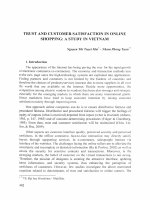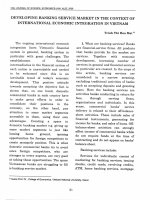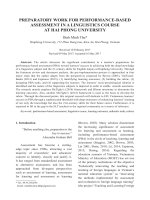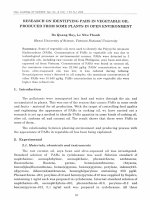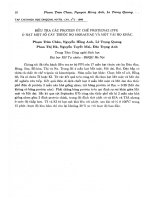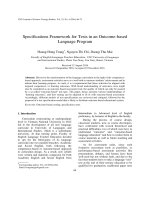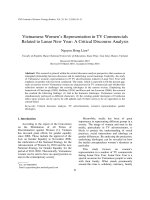DSpace at VNU: Specifications Framework for Tests in an Outcome-based Language Program
Bạn đang xem bản rút gọn của tài liệu. Xem và tải ngay bản đầy đủ của tài liệu tại đây (298.07 KB, 10 trang )
VNU Journal of Science: Foreign Studies, Vol. 32, No. 4 (2016) 64-73
Specifications Framework for Tests in an Outcome-based
Language Program
Hoang Hong Trang*, Nguyen Thi Chi, Duong Thu Mai
Faculty of English Language Teacher Education, VNU University of Languages
and International Studies, Pham Van Dong, Cau Giay, Hanoi, Vietnam
Received 12 August 2016
Revised 24 September 2016; Accepted 22 November 2016
Abstract: Driven by the transformation of the language curriculum in the light of the competencebased approach, assessment activities serve as a tool both to measure students‟ achievement and to
inform their learning progress. As such, it is a requirement that those activities be aligned with
targeted competence, or learning outcomes. With broad understanding of outcomes, tests might
also be considered as an outcome-based assessment tool, the quality of which can only be assured
by a so-called “outcome-based” test spec. This paper, hence, presents various understandings of
„learning outcomes‟, and how testing can be adjusted to fit in with outcome-based assessment.
Accordingly, different models of test specifications are reviewed and critiqued, followed by the
proposal of a test specification model that is likely to facilitate outcome-based educational system.
Keywords: Outcome-based, testing, specification, tests.
1. Introduction
Intermediate to Advanced level of English
proficiency, by lecturers of English in the faculty.
During the process of course design,
classroom teachers, now as course developers,
have confronted with several theoretical and
practical difficulties, two of which were how to
understand “outcome” and “outcome-based
language education” and how to realize them in
course materials as well as future teaching and
assessment activities.
As for assessment tasks, since such
formative assessment tools as portfolios, or
performance-based assessment activities like
presentations, debates, and forums have been
well-used but not without fault, and due to the
fact that students have to take a language “exit”
test at the end of their tertiary education to be
qualified for graduation, traditional paper tests
Curriculum restructuring at undergraduate
level in Vietnam National University in 2012
led to the development of all new language
curricular in University of Languages and
International Studies, which is a subordinate
university. At that turning point, Faculty of
English Language Teacher Education decided
to opt for the bifurcation of its language
curricular into two parallel branches: Academic
and Social English, both following the
competence-based or outcome-based approach
to curriculum design. As a result, new syllabi
were written and materials composed, for both
Academic English and Social English from
_______
Corresponding author. Tel.: 84-965242384
Email:
64
H.H. Trang et al. / VNU Journal of Science: Foreign Studies, Vol. 32, No. 4 (2016) 64-73
have also been selected to provide a more
accurate and comprehensive picture of an
individual student‟s language proficiency.
A question arising then to the course
designers was how a test in the outcome-based
language program might be different from a
“traditional” test, i.e. the test that had been
composed and delivered so far. Differences if
exist must be well and clearly presented in test
specifications as test specifications, or test
specs, are the blueprint for teachers to write a
good quality test.
Hence, this research was conducted to find
out the structure or components of a
specification for “outcome-based” tests and
features of a test specification that make it more
“outcome-based”. In particular, this research
aims at answering two questions:
1. What are components of a specification
for an “outcome-based” test?
2. What are the feature(s) of the test spec
that can make it “outcome-based”?
To answer these questions, we started by
investigating the literature of “outcomes”,
“outcome-based assessment”, and “test
specification” design. Later, through content
analysis and practical experience as classroom
test writers, we have come up with an electic
model of test specification, with features that
we believe can facilitate outcome-based
language program.
2. Theoretical background
2.1. Outcome-based assessment and testing
Outcome-based assessment derives its name
from outcome-based education approach, the
practice of which can be traced back to the
1960s and 1970s [1]. However, it was not until
a long time later that the theory of outcomebased education was discussed by a great
number of scholars such as [2-6], to name
but a few.
65
Outcome-based education (OBE) is
commonly understood as an educational system
in which teaching, assessment and learning are
based on the intended results. In other words,
by the end of the educational process students
are expected to be able to achieve the
predetermined learning outcomes. Outcomebased assessment, hence, refers to the procedure
in which learners are assessed against those
outcomes.
As suggested by the term, learning
outcomes are key to the proper understanding
and application of OBE in general and
outcome-based assessment in particular. Even
this concept of “outcomes” varies considerably
among language experts. Generally, there can
be two approaches to view “outcomes”. In its
narrow sense, “outcomes are actions/
performances that embody and reflect learner
competence in using content, information, ideas
and tools successfully” [6: 13]. Purser [5: 5]
also affirms:
Learning outcomes are important for
recognition [...] The principal question
asked of the student or the graduate will
therefore no longer be „what you do to
obtain your degree?‟ but rather „what can
you do now that you have obtained your
degree?‟ This approach is of relevance to
the labour market and is certainly more
flexible when taking into account issues of
lifelong learning, non-traditional learning,
and other forms of non-formal educational
experiences.
As such, “outcomes” refer to what learners
“can do”; knowledge, skills, and attitudes are
not outcomes themselves but contribute to the
demonstration of competence or learning
outcomes. Given this, alternative assessment
method, rather than traditional methods like
paper-and-pencil tests, would be preferable
since they provide simulated conditions for
learners to demonstrate their language abilities.
In contrast, outcomes could be more
broadly defined to include not only
performances but also knowledge, skills and
66
H.H. Trang et al. / VNU Journal of Science: Foreign Studies, Vol. 32, No. 4 (2016) 64-73
attitudes, as evidenced by learners‟ actions.
This understanding of outcomes implies a more
flexible approach to assessment. Outcomebased assessment, as a result, can even employ
tests as long as it is possible to elicit desired
knowledge and skills from test takers.
Outcome-based assessment is by no means
a new assessment approach. It still utilizes good
assessment practices that have been available in
other educational systems. However, outcomebased assessment does possess certain unique
features which distinguishes itself from other
approaches to assessment [7]:
1. Outcome-based assessment appears to be
formative rather than summative although it
cannot be said that summative assessment does
not exist in outcome-based education.
2. Outcome-based assessment is criterionreferenced, or more broadly, standardsreferenced.
3. Outcome-based assessment must allow
possibility of discriminating students across
different levels of achievement, which should
not be simply a pass-fail scale.
As
incorporated
in
outcome-based
assessment, a test, therefore, must comply with
those above-mentioned principles, meaning that
it has to be written with a clear set of expected,
measurable outcomes in mind, which then
allows differentiation among test-takers and a
test should be used to foster future learning
instead of summarizing a learning process.
2.2. Popular test specification models
In order to produce a “good” test that is
valid and reliable, test construction process
plays the key role, in which a test specification (or
test spec) is irreplaceable no matter how detailed
it might be or which format it might adopt.
Test specifications “are the design
documents that show us how to construct a
building, a machine, or a test” [8: 127]. Put it
another way, they detail the nature of the items
and the reasons why they are used in the test. In
this sense, specifications play a vital role in
ensuring the clarity of test forms so that they can
be duplicated across different test times [9: 8].
With regard to outcome-based education
which operates along a set of predetermined
outcomes, it is crucial that the link between
assessment activities (including tests) and
learning objectives be clearly shown, because
without which, no inferences about students‟
level of achievement can be made. Therefore,
test specifications seem to be even more
important.
Fulcher [8] has summarized five types of
specifications that may be included in a
complete test spec:
Table 1. Types of specifications in a test
Specification type
Item/task specifications
(i.e. prompt attributes)
Evidence specification
(i.e. response
attributes)
Test assembly
specification
Presentation
specification
Delivery specification
Basic function
Provide description of the prompts or the items or tasks in the test (e.g. the type of
input material, wording of the instructions, sample items, sample anti-items, etc.)
Provides description of test takers‟ expected performance and scoring method
Provides details on how the whole test is developed (e.g. number of each item type,
the target reliability and the minimum number of items needed to meet this target,
etc.)
Provides information on how the items and test material are presented to test takers
(e.g. margin size, spacing, the place to put page numbers, etc.)
Provides information on test administration, test security and timing (e.g. space
between desks or computers in a test room, number of invigilators per number of
test takers, what is (not) allowed to use during the test, etc.)
H.H. Trang et al. / VNU Journal of Science: Foreign Studies, Vol. 32, No. 4 (2016) 64-73
These five types of specifications can be
realized in a real test specification under
different labels (or components). Following are
three different popular test specification formats
for test writers, which have been put forward by
notable language assessment experts.
The first format, proposed by Popham
(1978, 1981), has gained much popularity
among language specialists and educators for
its simplicity and efficiency . This fivecomponent spec includes:
general description: description of the
behaviour or skill to be assessed, the
focus of assessment, the learning
objective or goal taken from the
syllabus, and any contextual or
motivational
constraints
in
the
particular test setting
stimulus attributes: (i.e. the prompt
attribute) description of everything
related to the test items or test tasks
given to test takers, which makes clear
the link between the tasks and the
learning goals or objectives that they
are trying to aim at.
response attributes: description of
examinees‟ expected response
sample item: presents the actual look
of an item/task
specification supplement: provision of
further details necessary for test
developers to facilitate test construction
work (e.g. a list of potential text types,
a list of potential topics, etc.)
[9: 14]
The second model [10], the Bachman &
Palmer one, has the following parts:
purpose: an explicit statement of how
the test item/task should be used.
definition of the construct: a detailed
description of the construct, or
particular aspect of language ability,
that is being tested. This includes the
inferences that can be made from the
test scores, which overlaps with the
purpose of the test.
67
setting: a listing of the characteristics physical location, participants, and time
of administration - for the setting in
which the test will take place.
time allotment: the amount of time
allowed for completing a particular set
of items or a task on the test.
instructions: a listing of the language
to be used in the directions to the test
takers for the particular item/task.
characteristics of the input and
expected response: essentially a
description of what will be presented to
the test takers (i.e., prompt attributes)
and what they will be expected to do
with it (i.e., response attributes)
scoring method: a description of how the
test taker response will be evaluated.
The last spec format to be reviewed is
developed by Alderson et al. [11]. who
advocate the variation in format and content of
a test spec depending on which audience it is
targeting at. According to these experts, the
audience of test specs can be categorized into
test writers, test validators, and test users.
Within the scope of this paper, only the spec
format for test writers is discussed below:
general statement of purpose: states
the purpose of the test, that is, to
diagnose students‟ strengths and
weaknesses, to place students into
suitable classes, to measure students‟
achievement after a course of study,
and so on
test battery: lists the components of
the overall test (e.g., reading, writing,
listening, speaking) with the time
required to complete each
time allowed: gives the time provided
for the individual component being
covered by the spec (e.g., reading)
test focus: provides information about
the general levels of proficiency the test
is meant to cover, along with a
description of the particular subskills or
knowledge areas to be tested (e.g.,
skimming, scanning, getting the gist)
H.H. Trang et al. / VNU Journal of Science: Foreign Studies, Vol. 32, No. 4 (2016) 64-73
68
source of texts: indicates where
appropriate text material for the test
tasks can be located (e.g., academic
books, journals, newspaper articles
relating to academic topics)
test tasks: specifies the range of tasks
to be used (e.g., relating this section to
the subskills given in the “test focus”
section)
item types: specifies the range of item
types and number of test items (e.g.,
forty items, twelve per passage,
including
identifying
appropriate
headings, matching, labeling diagrams)
rubrics: indicates the form and content
of the instructions given to the test takers.
Practically, most of the components of these
frameworks are realized in public test spec of
major English tests (e.g. IELTS, TOEFL iBT,
and Cambridge First Certificate Exam). Some
components which are witnessed in one test,
and not in the others encompass: “response
attribute” (Popham, 1981) (as cited in [9]),
“source of text” [11], “definition of construct”
[10], and “instruction” [11, 10, (Popham,
1981)]. Based on public information of these
tests [12-14], their realization of spec
components is summarized in the table below:
Table 2. How components of different spec models are used in major standardised tests
Popham (1981)
General description
Bachman & Palmer
(1996)
Purpose
Time allotment
Stimulus attributes
Setting
Definition of
construct
Instructions
Characteristics of the
input ...
Response attributes
Alderson et al. (1995)
IELTS
FCE
X
TOEFL
iBT
X
General statement of
purpose
Test battery
Time allowed
Test focus
X
X
X
X
X
X
X
X
X
X
X
Rubrics
Source of texts
Test tasks
X
X
X
X
Item types
X
X
X
X
X
X
X
X
X
X
… and expected
response
Sample items
Scoring method
Specification
supplement
3. A recommended specification framework
for “outcome-based” tests
While Popham‟s (1978, 1981) (as cited in
[9]) test specification format emphasizes the
importance of sample items by considering
them as a separate component in a test
specification, the two other formats do not
make sample items so explicit. For Alderson
and colleagues, sample items are more
necessary for teachers and learners or test takers
than test writers because candidates need such
essential information to familiarise themselves
with the test prior to taking it . Moreover, the
way Popham termed the first part of the spec
General Description appears to be rather broad
H.H. Trang et al. / VNU Journal of Science: Foreign Studies, Vol. 32, No. 4 (2016) 64-73
and ambiguous although this section also takes
test objectives as its core, just like the first
section of the other models. Besides, although
Popham‟s model does not specify how the test
will be scored, it does include Specification
Supplement, which provides room for
flexibility in a test spec, thus, undoubtedly
benefit test writers by providing further
necessary information about test development.
Regarding the spec model proposed by
Bachman & Palmer [10], almost all components
are similar to Popham‟s (but under different
names), except for the lack of Sample Items and
the inclusion of Definition of the Construct.
Bachman & Palmer really want to make clear
the tested language ability as a way to validate
the coming test tasks and to strengthen the link
between test tasks and test objectives. As for
the model by Alderson et al. [11], the fact that
neither response attributes specification nor
setting (i.e. delivery specification) nor scoring
method exists might derive from the authors‟
viewpoint of tailoring the test specification
format for different target users. The
aforementioned format aims at test writers,
hence, such sections like response attributes,
setting or scoring method can be omitted.
Given the three models above with their
strengths and weaknesses as well as their
practical use in popular international language
tests, an eclectic model that hopefully can
tackle the requirements for a test in an outcomebased syllabus is formulated. Below are major
components of the suggested spec together with
an example. Such elements like title of the spec
or spec version has already been trimmed.
- Statement of purpose: briefly describes
the purpose of designing and using the test or
the reason(s) why such a test is necessary, that
is, for example, to check the progress of
students (progress test), to evaluate what
students have been able to achieve after the
course (achievement test), to place students in
suitable classes (placement test), and so on.
Eg. This test is designed to measure
students’ achievement after fifteen weeks
69
learning and practising academic language and
skills.
- Test objectives: identifies the course
objectives that the test is going to cover, that is,
the tested knowledge, skills and abilities.
Eg. Based on the course guide, the
following listening sub-skills will be tested with
varying degrees of significance:
1. Realizing the purposes of
different parts of a lecture
2 items
2. Realizing the relationships
between parts of a lecture
2 items
3. Inferring a lecturer’s opinion
3 items
4. Identifying specialized terms in a
lecture
3 items
5. Following description of features
/ processes in a lecture
5 items
6. Following the main points made
in a lecture
5 items
7. Identifying supporting detail in a
lecture
10 items
Total
30 items
- Test tasks: overviews the possible types of
tasks to be covered in the test in order to meet
the test objectives, together with the number of
questions and time allocation for each task. A
list of possible task types for each test objective
should be made in order to avoid test-oriented
instruction.
Eg.
Tested skills
Can understand main idea
of instructions
Can identify details which
are clearly stated
Question/Task type
Gap-filling
Matching
Item
specifications:
describes
instructions, input materials, features of test
items and sample items for each item type. Also
this section should detail instructions on
designing items that can differentiate different
levels of students‟ achievement of test
objectives.
70
H.H. Trang et al. / VNU Journal of Science: Foreign Studies, Vol. 32, No. 4 (2016) 64-73
For a language test, one way to design a test
which can differentiate students‟ level is by
incorporating both items at one-level lower and
one-level higher than the target level of the test,
besides the items at the target level. For tests
including items at only the target level, the
difficulty of test items can also be reflected in
the level of cognitive demands for student testtakers. To design questions with different
cognitive demands, teachers can refer to the
Bloom‟s taxonomy and/or the Structure of
Observed Learning Outcomes (SOLO) for
useful guidelines.
Part 1:
Eg.
·
6 instructions, guidelines, announcements
·
Each instruction/ announcement includes around 50 to 90 words
·
Instruction may also include 3 to 5 turns
·
Speed: 120 - 190 words/minute
·
Topic: varied on social themes - unit 1-8 (4A Course guide)
Level of input: C1
Sample instruction and item:
PART 1
In this part, you will hear SIX short announcements or instructions. There is one question for
each announcement or instruction. For each question, fill in the blank with NO MORE THAN 3
WORDS AND/OR A NUMBER.
Question 1. The flight VN701 to Lyon has been delayed due to __________.
- Response specifications: this section is
optional for an objective test with the selected
response format whereas it is essential for a
subjective test in which the students have to
construct their own responses.
Eg:
· Students write answers to Wh-questions
using their words.
· The answers must be within a word limit
(no more than 50 words).
· The answers must rely on some evidence
extracted from the text.
·
Accurate spelling and grammar are
expected for a correct answer; however, quality
of ideas should receive more weight.
- Test presentation: specifies how to
present the items and other input materials, for
example, the margin size, the font type and size,
spacing, and other formating features.
Eg. See “Scripts for test instructions” below
- Scoring method: clarifies how to score
objective item types or mark subjective
responses.
Eg. Each correct answer is awarded 1 pt.
The whole test with 20 questions has the total
mark of 20 pts, which is finally divided by two
to convert to the 10-point grading scale.
H.H. Trang et al. / VNU Journal of Science: Foreign Studies, Vol. 32, No. 4 (2016) 64-73
71
Scripts for test instructions:
[2] Section 1
Now turn to section one
Listen to …
Then, answer Questions 1-10.
You will listen to the recording ONCE only.
First, you have some time to look at questions one to ten
[ Silence = 45 seconds (10 items) ]
Now listen carefully, and answer questions one to ten.
[ Recording 1]
Test format:
Font type: Times New Roman
Font size: 12
Spacing: Multiple - 1.12
Margin: Top 1.5 cm, Bottom 1.5 cm, Left: 2 cm, Right 1 cm, Header 0.5 cm, Footer 0.5 cm
- Specification supplement: this section
provides further information that item writers
may need in order to write an effective test, for
example, how to identify levels of text
difficulty (for reading passages), possible
sources of texts, etc.
Eg.
How to decide on the difficulty level of a
recording:
Difficulty of a recording can be decided by
the following factors:
- Speed of delivery: this can be calculated
by dividing the number of words delivered by
the length of the recording. For example: your
recording lasts 5 minutes 20 seconds (or 320
seconds) and the script has 400 words. Then the
delivery speed is 400:320, which equals 75
words per minute.
The eight-component model presented
above incorporates the most preferred features
of the three models put forward by Popham
(1981, 1994) (as cited in [9]), Bachman &
Palmer [10] and Alderson et al. [11]
respectively. The reason why there exists “the
statement of purpose” section is that we want to
clearly position the test in the course timeline to
decide its general role and goal. This is
essential in outcome-based education as the
goal of outcome-based assessment should be
formative rather than summative. Moreover,
with the identification of the general goal of the
test, and later the course objectives that the test
addresses, the test is more likely to be properly
and closely aligned with outcome-based
instruction. This also explains why “course
objectives” are set as a separate component of
our spec. More importantly, what distinguishes
this spec model from the others of the same
type is the content of “item specifications”.
Besides common information about test items,
this section is also supposed to do further by
pointing out what and how test writers can
write items that help reveal different levels of
students‟ achievement of course objectives.
Instead of the usual pass-fail scales, more
meaning about students‟ language ability will
be added to the scores of tests designed from
this suggested spec.
Furthermore, instead of using the terms
“prompt attributes” and “response attributes” as
in Popham‟s model, “item”, “response” and
“specifications” have been utilized. In practice,
classroom teachers in many cases are also test
writers and the fact that test spec appears less
72
H.H. Trang et al. / VNU Journal of Science: Foreign Studies, Vol. 32, No. 4 (2016) 64-73
technical and more teacher-friendly will make it
a less frightening experience for teachers when
having to use it to develop a test. Also, “test
presentation” is included to ensure consistency
in format in case more than one person takes
responsibility
in
test
development
process. “Scoring method” also exists for the
purpose of clarity and convenience since test
scores might need to be converted to match the
grading system that is currently in use in each
institution.
Additionally, “specification supplement” is
added to facilitate teacher‟s process of test
design. This section is supposed to include
anything that a teacher needs to know in order
to develop the test, which has not been
addressed in the previous sections.
Lastly, the most important feature that
makes this test spec more “outcome-based” is
the content of the item specifications, which
should show test designers how to write items
of
different
levels
of
difficulty.
Consequentially, students, instead of receiving
a “fail” or “pass” score, would know which
level they are at and then possibly be shown (by
their teachers or peers) what they should do in
order to reach their target level of achievement.
4. Conclusion
To sum up, paper-and-pencil tests can be
clearly incorporated in continuous assessment
highlighted in outcome-based education as long
as the test purpose and contents bear all of its
hallmarks, that says, formative and standardsreferenced. In this sense, test specifications
have a critical role to play in aligning tests with
learning outcomes in outcome-based education.
The three reviewed spec models have certain
similarities and differences which are possibly
beneficial in various contexts; however, tests
designed in accordance with these models may
not be explicitly viewed as “outcome-based”
tests. Taking the attributes of outcome-based
assessment, a more “outcome-based” test spec
model has been proposed, components of which
are developed upon the review and critique of
those available models as well as of different
aspects in a number of favored international
language tests. It is hoped that the proposed
model facilitates test development process in an
outcome-based English language program.
Acknowledgements
This research has been completed under the
sponsorship of the University of Languages and
International Studies (ULIS, VNU) in the
project No N.15.07.
References
[1] Kennedy, D., Hyland, Á. & Ryan, N. Writing and
using learning outcomes: A practical guide.
Retrieved
on
June,
26th
2016
from
/>development/assets/pdf/ Kennedy_ Writing_ and_
Using_Learning_Outcomes.pdf.
[2] Harden, R. M. (2007). Outcome-based Education:
The future is today. Medical Teacher, Vol. 29.
[3] Kenney, N., Desmarais, S. (n.d.) A guide to
developing and assessing learning outcomes at the
University of Guelph.
[4] Malan, S. P. T. (2000). The „new paradigm‟ of
outcomes-based education in perspective.
Tydskirf
vir
Gesinsekologie
en
Verbruikerswetenskappe, Vol. 28.
[5] Pulser, L. (2002). Recognition in the European
higher education area: An agenda for 2010. To be
reported at the international seminar of
recognition issues in the Bologna process, Lisboa,
Fundação Calouste Gulbenkian, 11 – 12 April.
[6] Spady, W. G. (1994). Outcome-based education:
Critical issues and answers. U.S.A: American
Association of School Administrators.
[7] Killen,
R.
(2000).
Standards-referenced
assessment: Linking outcomes, assessment and
reporting. Keynote address to be presented at the
Annual Conference of the Association for the
Study of Evaluation in Education in Southern
Africa, Port Elizabeth, South Africa, 26-29
September.
[8] Fulcher, G. (2010). Practical Language Testing.
Great Britain: Hodder Education.
[9] Davidson, F. & Lynch, B. K. (2002). Testcraft: A
teacher‟s guide to writing and using language test
specifications. Canada: Yale University Press.
H.H. Trang et al. / VNU Journal of Science: Foreign Studies, Vol. 32, No. 4 (2016) 64-73
[10] Bachman, L. F. & Palmer, A. S. (1996). Language
testing in practice: Designing and Developing
useful language tests. Hong Kong: OUP.
[11] Alderson et al. (1995). Language test construction
and evaluation. UK: CUP.
[12] Information for candidates: introducing IELTS to
test takers. Retrieved on June 30 th 2016 from
www.IELTS.org.
[13] ETS. TOEFL iBT Research Insight: TOEFL iBT
test framework and test development. Series 1,
73
Vol. 1. Retrieved on July 1st 2016 from
/>insight.pdf.
[14] Cambridge English Language Assessment.
(2015). Cambridge English: First handbook for
teachers. Retrieved on July 1st 2016 from
/>ge-english-first-for-schools-handbook-2015.pdf.
Bảng đặc tả kỹ thuật cho bài kiểm tra
trong khóa học ngôn ngữ theo định hướng chuẩn đầu ra
Hoàng Hồng Trang, Nguyễn Thị Chi, Dương Thu Mai
Khoa Sư phạm tiếng Anh, Trường Đại học Ngoại ngữ, ĐHQGHN,
Phạm Văn Đồng, Cầu Giấy, Hà Nội, Việt Nam
Tóm tắt: Cùng với việc chuyển đổi chương trình học ngôn ngữ theo định hướng chuẩn đầu ra, các
hoạt động kiểm tra đánh giá đóng vai trò như một công cụ vừa để đo mức độ hoàn thành của người
học, vừa để cung cấp thông tin về tiến bộ học tập của họ. Do đó, những hoạt động kiểm tra đánh giá
này phải thống nhất với các mục tiêu đã được đề ra của khóa học. Nếu hiểu mục tiêu khóa học theo
nghĩa rộng, thì bài kiểm tra cũng có thể được coi là một công cụ đánh giá dựa trên chuẩn đầu ra, và vì
lẽ đó, chất lượng của nó chỉ có thể được đảm bảo thông qua một bảng đặc tả kỹ thuật, tạm gọi là
“Bảng đặc tả kỹ thuật cho bài kiểm tra dựa trên chuẩn đầu ra”. Mục tiêu của bài viết này là trình bày
những cách hiểu khác nhau về “kết quả học tập” hay “chuẩn đầu ra” và làm thế nào mà bài kiểm tra
có thể được điều chỉnh cho phù hợp với đường hướng kiểm tra đánh giá dựa trên chuẩn đầu ra này. Từ
đó, những mô hình khác nhau của Bảng đặc tả kỹ thuật cho bài kiểm tra đã được xem xét và phê bình,
làm cơ sở để xây dựng một mô hình gợi ý cho Bảng đặc tả kỹ thuật của bài kiểm tra theo hướng dựa
trên chuẩn đầu ra của khóa học.
Từ khóa: Chuẩn đầu ra, kiểm tra, bảng đặc tả kỹ thuật, kiểm tra đánh giá.
